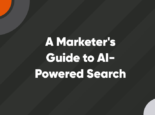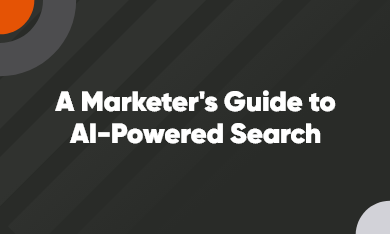
Google’s AI Mode and the Impact on SEO
Google's AI Mode is the newest addition to Google’s suite of AI tools and presents a new way of searching Google that makes it easier for users to ask complex or multi-part questions, pick up where they left off on a research task, or figure out where to get a gluten-free pizza.
AI Mode is great at understanding natural language, finding up-to-date information on people, places, events, and products, and even writing code. Is Google’s AI Mode a game changer for the search landscape? As a generative engine optimization agency, we’re exploring how AI-powered search engines are changing SEO strategies and how marketers can adapt. Follow along as we get to know Google’s AI Mode and discuss its impact on SEO strategies.
How does AI Mode work?
AI Mode aims to make search more intuitive, efficient, and engaging by leveraging AI to understand and respond to users’ questions in a way that resembles human conversation and thought patterns.
Until recently, LLMs were not great at answering multi-part questions, carrying out compound instructions, or handling follow-up and drill-down questions. LLMs operate from a set lexicon of potential answers and references that is continually updated by the LLM's modelers. LLMs can’t think the way humans do, but the latest LLM models, like AI Mode and ChatGPT-4, come closer than ever before. With AI Mode, users can pose complex, multi-part questions like this one:
Find the restaurant with the best cheeseburger in Minneapolis that not only delivers late but also offers gluten-free hamburger buns.
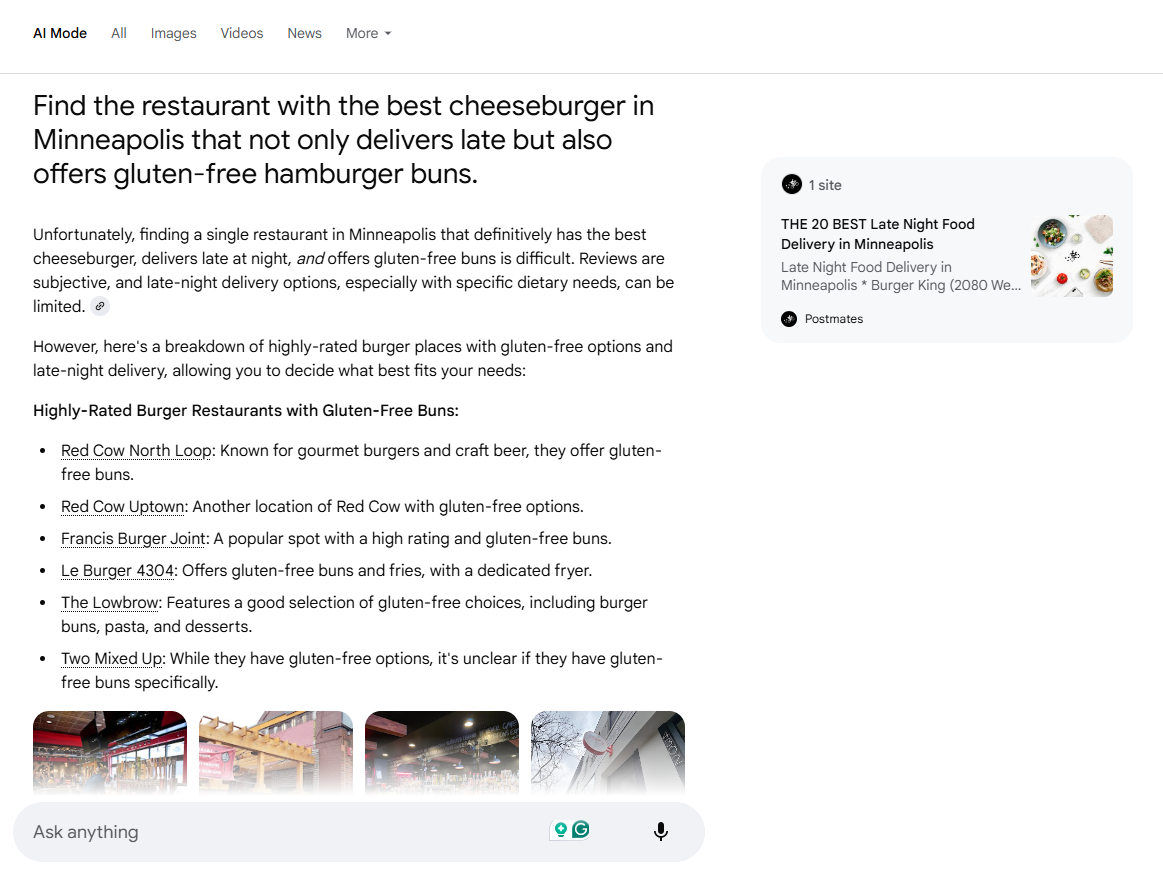
This question is much more complex than a query you’d type into a traditional search engine. Responses to this type of question allow users to get more personalized, in-depth answers. In the result above, AI Mode struggles to find a definitive, clear winner of the best cheeseburger that’s available for late-night delivery and also has a gluten-free bun, but it offers a variety of recommendations and includes qualifiers and other important considerations, all in a conversational tone. AI Mode indicates a greater transition from keyword-oriented search to contextual, conversational search.
How does AI Mode differ from traditional Google Search?
Google’s AI Mode is a way of searching within Google, just like Image Search and Shopping. But although AI Mode lives within Google Search, it functions much differently from traditional search.

AI Mode employs a “query fan-out” technique, issuing multiple related searches concurrently across subtopics and multiple data sources, and then bringing those results together to provide an easy-to-understand response.
In other words, AI Mode asks multiple sources the same or similar questions and sub-questions to gather information, sort it, organize it, and provide the user with a direct answer that includes information the AI believes will be most helpful and reliable. This approach helps users access more breadth and depth of information than a traditional search on Google, all in one place. So, rather than returning a page of blue links, users get in-depth, personalized results. Pretty cool, huh?
Where does AI Mode get its information from?
Powered by Gemini 2.0, AI Mode gathers information from a variety of sources, including:
- The internet
- Google’s Knowledge Graph
- Google’s Shopping Graph
- Location and proximity data
- Real-time data sources
Based on the type of question, AI Mode can pull from a vast number of resources. If a user asks to compare three products, AI Mode might utilize the Shopping Graph, the open web, and location and proximity information to tell you where you might buy those products near you.
The benefits of searching with AI Mode
From speedy answers that are deeply personalized to the ability to ask follow-up questions and dive deeper into topics, there are plenty of benefits to using AI Mode.
Conversational search
AI Mode allows users to ask questions using natural language, just like in a conversation, rather than relying solely on keywords. It can handle complex, multi-faceted queries and follow-up questions, enabling users to explore topics in greater detail.
Users can provide input through text, voice, or even by uploading images, and receive AI-powered responses. So whether you’re looking for a new dinner spot or the must-have items for your next trip, you’ll get rich, reliable information in AI Mode to help you confidently make a decision, take action, or plan next steps.
Information retrieval and synthesis
When a user asks a question, AI Mode taps into Google's powerful information systems, including its search index, Knowledge Graph, and real-time data sources.
Its AI model, Gemini, uses advanced reasoning to analyze the query and devise a plan to gather relevant information. It then synthesizes information from various sources to provide a comprehensive and well-structured response.
Enhanced search experience
AI Mode goes beyond simply listing web links; it provides concise and informative answers, often in the form of bullet points or sidebars, along with links to the original sources. It may also display interactive elements like product and place cards, providing real-time information like pricing, availability, reviews, and more.
So many of the questions people ask are part of longer-running tasks and projects, and often they want to get back to the information they found. AI Mode makes it easier to jump right back into what you were doing.
Integration with Google Lens
A recent enhancement integrates Google Lens with AI Mode, allowing users to upload images and photos as part of their search query. This enables AI Mode to understand the context of an image and provide detailed information about objects, scenes, and their relationships. Users can ask questions about what they see in a photo and receive helpful answers, shopping links, and even related videos.
The limitations of searching with AI Mode
AI Mode in Google Search, while offering a more natural, conversation-based search experience, is not without its limitations. Some of the current limitations include accuracy and reliability issues, transparency and source evaluation/qualification, limited access, privacy concerns, and disruption to the digital marketplace.
Accuracy and reliability
Similar to other AI models, AI Mode can hallucinate, providing incorrect or misleading information to users rather than admitting they don’t have the answer. LLMs can struggle to differentiate between reliable and unreliable sources, which can lead to presenting false information as factual.
LLMs are also prone to bias based on the data they’re trained on, so watch out for misinformation or bias when generating responses using AI Mode and other AI tools.
Transparency and source evaluation
Because AI Mode synthesizes information from a number of sources, it can be harder to evaluate the context and credibility of each individual source. Attribution can also be a challenge as AI Mode struggles to accurately connect specific information to the correct original source.
There’s also the risk that personalized AI results could become echo chambers for users, where the AI shares information that it thinks the user would agree with, rather than a variety of sources that highlight different perspectives. Traditional results have the potential to provide a wider variety of sources that aren’t based as heavily on the user’s preferences.
AI Mode’s impact on SEO
Now that we’ve covered AI Mode, let’s discuss its potential impact on SEO.
Loss of organic traffic
As generative search continues to grow, AI tools like AI Mode will take traffic away from websites that rank in traditional search results. AI Mode's integration into Google Search may reduce website traffic as users increasingly rely on AI-generated summaries instead of visiting web pages.
AI Mode’s in-search answers will reduce the need to click through to external pages, so website owners and SEOs will have to find new ways to drive traffic to their sites.
Users are searching in a variety of ways, whereas in the past they relied primarily on Google. And while many users still turn to Google to search, they're also incorporating ChatGPT, Claude, and now AI Mode to get results. This impacts the user journey and website traffic. As these trends continue, marketers will have to get creative with how they bring traffic to their websites.
Loss of ad revenue
This shift could also impact ad revenue and force publishers to update their content strategies to focus more on creating unique, in-depth content that AI can’t easily replicate, such as video and podcasts.
Search intent ratios for site users may shift for those who view and interact with your website.
Rethinking your SEO strategy
Knowing that the search landscape is continuing to change, where do you focus your SEO strategy in the face of generative search?
The traditional SEO approach may become less effective as AI Mode and other AI tools prioritize synthesized answers over organic search results, forcing content creators to adapt. Here’s how you can rework your strategy to show up in traditional search and in AI-powered search.
Incorporate generative engine optimization
Shifting website traffic patterns always forces a learning curve in terms of how to harness new strategies, whether to shift strategies, and how to time them. Start rethinking your strategy sooner rather than later, and begin to incorporate generative engine optimization strategies that can help your business show up in generative engine results.
Major aspects of generative engine optimization include making sure generative engines can discover information about your business and understand what your business does so that they will choose to mention your brand over your competitors. Ensure your brand has plenty of positive reviews, don’t block AI search tools from crawling your website, and work on clarifying your brand perception online. Positive brand positioning is crucial.
Re-evaluate your measurement strategies
If you are an in-house marketer and have been relying heavily on traffic reporting, begin resetting expectations with stakeholders to focus more on the quality of interactions and engagement time, rather than the quantity of site visits. You should also set up measurement strategies for tracking traffic from generative AI.
Anyone who was focused on measuring impression counts and number of clicks versus conversions, results, and outcomes will face a changing marketplace, in favor of aligning business goals with SEO goals, strategies, and tactics. Consider shifting your focus to improving site engagement time and increasing key event conversions rather than worrying too much about lost traffic that may or may not have been converting.
Show up where your audience is searching with Perrill
With the rise of generative search, one thing is clear: sticking to your old SEO strategy isn’t going to cut it anymore. It’s time to build a robust search strategy that combines SEO with generative engine optimization so you can show up everywhere your audience is looking for you.
Ready to get started? Reach out to discuss adding generative engine optimization to your digital strategy.

Jen Jones
Author
Jen Jones
Categories
Date
Explore with AI
Join Our Newsletter

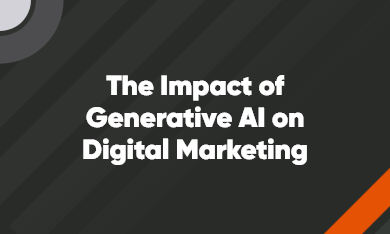
The Impact of Generative AI on Digital Marketing

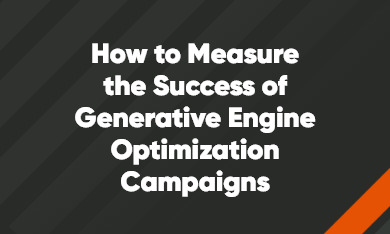
How to Measure the Success of Generative Engine Optimization Campaigns

